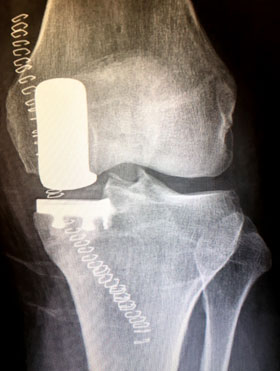Possibilities for UKA as encountered by the experts

The increasing number of elderly people who wish to maintain mobility throughout their lives keeps challenging the health care system. In particular, the orthopaedic and traumatology community now faces more cases of bone fragility, sarcopenia and wear of the joints. In the knee joint, arthroplasty replaces diseased or damaged weight-bearing surfaces to relieve pain or help individuals cope with disability.

In opposition to total knee replacement, which is currently one of the most common orthopaedic procedures worldwide, unicompartmental knee arthroplasty (UKA) may lead to lower postoperative pain and allow for a shorter recovery period. Moreover, UKA surgeries usually require a smaller incision, which causes limited tissue damage. As the future of orthopaedics is patient-specific treatment, a detailed disease pattern should be established in each case before deciding between one knee arthroplasty approach or another. Ideally, partial knee replacement should be considered whenever possible as it can lead to optimal functional outcome with lower comorbidity. The Vienna 2020 Interactive Expert Exchange, chaired by Prof. Emmanuel Thienpont, MD, MBA, PhD, from the University Hospital Saint Luc in Brussels, Belgium, will showcase the feasibility and restrictions of UKA as faced daily in the practice of several internationally recognized knee surgeons.
Thursday 11 June 2020 | 10:00 to 12:15
Partial Knee Replacement: How Far Can We Push It?
Introduction & Conclusions
Emmanuel Thienpont (Belgium)
Presentations & Questions
Primary indications for medial and lateral UKA | Anders Troelsen (Denmark)
Extended indications for medial and lateral UKA| Nick London (United Kingdom)
Primary and extended indications for PFJ replacement | Jonathan Eldridge (United Kingdom)
Combined small implants | Sébastien Parratte (France)
Discussion on clinical cases - What Would You Do?
Provocateurs: Carsten Perka (Germany) & Gijs Van Hellemondt (The Netherlands)
In partial knee arthroplasty, the implant resurfaces one compartment of the tibiofemoral joint, that being either the medial or the lateral compartment. With the first generation of UKA implants, the procedure was associated with a high failure rate during the 1990s. Later, the overall number of UKAs performed started to increase. Currently, 10% to 15% of patients receive this treatment compared with alternative approaches in the United States alone. Nevertheless, the indications for UKA are still controversial. In particular, the proportion of medial and lateral UKAs to be performed as a primary replacement, the main indications and contraindications for UKA and patellofemoral joint replacement, as well as the possibility of combining several small implants remain uncertain considerations.
Speakers on this Interactive Expert Exchange (IEE) panel will discuss the primary and obvious indications for UKA and the more extended and rare indications. Surgeons who are either believers or doubters of UKA should be comfortable with their indications after this part of the session. The faculty will then discuss the indications for patellofemoral joint replacement, followed by a final presentation on the combination of small implants. Multicombinations of implants lead to resurfacing solutions that conserve both cruciate ligaments and may be more appropriate for younger patients who perform high-demand activities. During this IEE, two provocateurs will defend total knee arthroplasty and state the difficulties faced in their practice for revisions of failed UKA.
The format of this exchange, including lectures, open debates and case presentations, will lead to a deep evaluation of all considerations for the surgeon who must decide between a unicompartmental or a TKA. The highly experienced surgeons in the specialty of knee arthroplasty will discuss pros and cons of each procedure to help attendees’ decision-making.

The IEE session entitled, “Partial Knee Replacement: How Far Can We Push it?” can be attended by any participant fully registered for the EFORT Congress without any extra fee to be paid. Sign-up for the Vienna meeting will be available on the registration platform as of 8 January 2020. Join the session and challenge the experts.
- For more information:
- All about the EFORT Annual Congress, 10 to 12 June 2020, Vienna, Austria
- Interactive Expert Exchange Sessions

